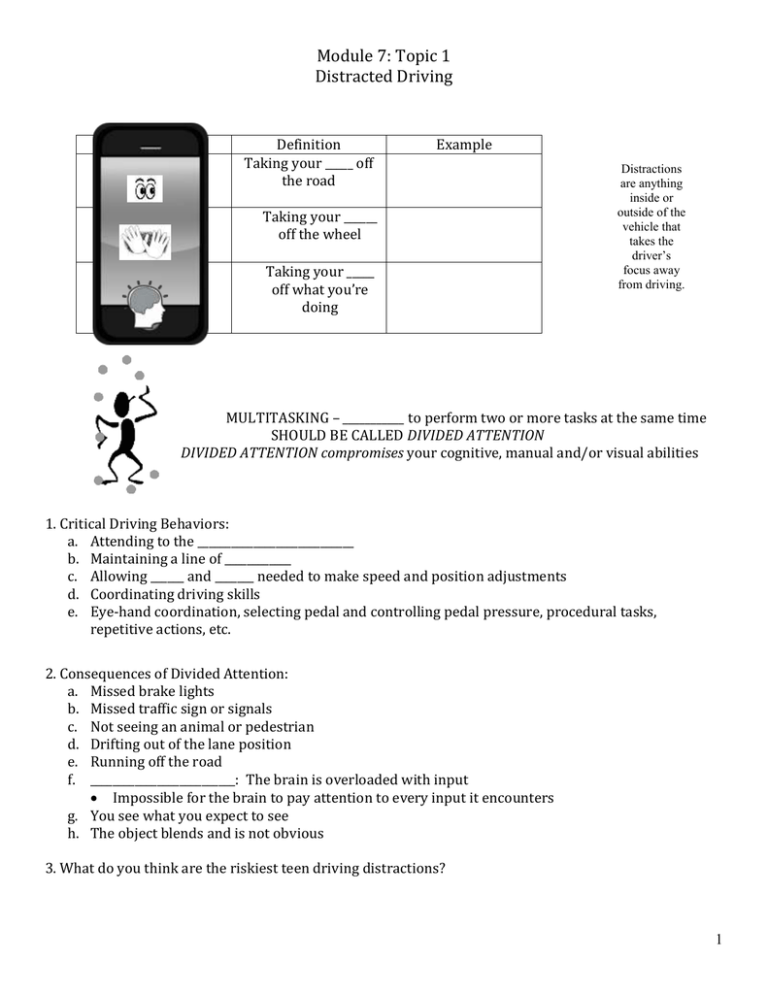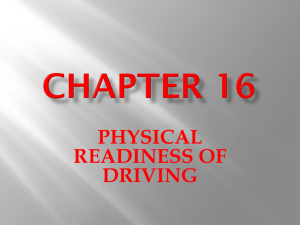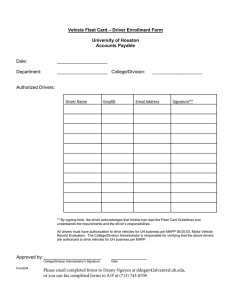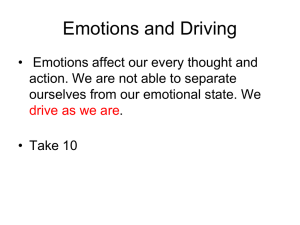Module 7: Topic 1 Distracted Driving
advertisement

Module 7: Topic 1 Distracted Driving Distraction Visual Definition Taking your _____ off the road Manual Taking your ______ off the wheel Cognitive Taking your _____ off what you’re doing Example Distractions are anything inside or outside of the vehicle that takes the driver’s focus away from driving. MULTITASKING – ___________ to perform two or more tasks at the same time SHOULD BE CALLED DIVIDED ATTENTION DIVIDED ATTENTION compromises your cognitive, manual and/or visual abilities 1. Critical Driving Behaviors: a. Attending to the ____________________________ b. Maintaining a line of ____________ c. Allowing ______ and _______ needed to make speed and position adjustments d. Coordinating driving skills e. Eye-hand coordination, selecting pedal and controlling pedal pressure, procedural tasks, repetitive actions, etc. 2. Consequences of Divided Attention: a. Missed brake lights b. Missed traffic sign or signals c. Not seeing an animal or pedestrian d. Drifting out of the lane position e. Running off the road f. __________________________: The brain is overloaded with input Impossible for the brain to pay attention to every input it encounters g. You see what you expect to see h. The object blends and is not obvious 3. What do you think are the riskiest teen driving distractions? 1 4. Do you know? a. You are _____ times more likely to be involved in a crash if you are texting. b. Drivers who send and receive text messages take their eyes off the road for an average of _____ seconds out of every _____ seconds while texting. c. At 55 miles per hour, this means that the driver is traveling the length of a ______________, including the end zones, without looking at the road. 5. How can children create distractions for the driver? 6. How can pets create distractions for the driver? 7. What is the law in VA? a. Under 18 and bus drivers No cell phones – hands free or handheld - ______________ law b. No texting – ______________ law GET THE WORD OUT What can you do to help other teens reduce distractions while driving? 2 Module 7: Topic 2 Driver Performance and Driver Fatigue 1. How many hours of sleep do you get during week day nights? 2. How many hours of sleep do you think you need? 3. Effects of Fatigue: a. Impairs reaction time, _______________, and vision b. Impairs senses and abilities - may not see objects clearly or in a timely manner c. May miss ___________ information – signs, lights and sounds d. Takes longer to process information or make decisions 4. Some Facts: a. 103 million people admit to have fallen asleep at the wheel b. Drivers may experience “heavy lids” (short bursts of sleep) or fall asleep for longer periods increasing the chance of a collision dramatically. c. The NHTSA estimates that ______________ police-reported crashes a year are the result of drowsy driving. d. Sleepiness and driving is a dangerous combination. It can impair drivers by causing slower reaction times, vision impairment, lapses in judgment and delays is processing information. e. Studies show that being awake for more than ______ hours is equivalent to a ________% BAC (blood alcohol concentration). 5. Causes of Fatigue: a. Physical strain (hard work) b. Mental strain (stress) c. Monotonous tasks (long driving trips) d. Illness e. Lack of sleep f. Sun glare g. Overeating h. Riding in a warm passenger compartment 6. Warning Signs of Fatigue: a. ________ eyelids b. Yawning repeatedly or rubbing eyes c. Daydreaming d. Trouble ________________ miles driven e. Trouble keeping head up f. ____________ from lane, following too closely or hitting a shoulder rumble strip g. Restless and irritable 7. Three Types of Fatigue: a. The first is lack of rest or _____________ . b. The second is _______________ fatigue, brought on by driving long hours in heavy traffic or adverse weather conditions. c. The third is the personal ____________ rhythm fatigue. Circadian rhythm is the body's natural "down time". It affects nearly everyone between 1 and 5 p.m. and around normal bedtime. 8. Preventing Drowsiness Behind the Wheel: a. Get adequate sleep – ________to _______ hours b. Prepare route to identify total distance, stopping points, and other logistics c. Drive with a __________________ d. Avoid medications that cause drowsiness 3 9. Maintaining Your Alertness: a. Wear sunglasses b. Avoid heavy foods c. Be aware of “___________” during the day d. Drive with a passenger and take __________ e. Take periodic breaks f. Take a nap if needed g. Consume caffeine – but do not rely on it 10. THIS DOES NOT WORK: a. “Toughing it out” b. Playing the radio loudly c. Driving at a faster or slower speed d. Chewing gum e. Opening the windows 11. Preventative Actions: a. Take a _______ for a few minutes before you start to drive b. Take a quiet, less congested route home c. Drive at a reduced speed d. Increase your following distance to allow more time to respond e. Be well-rested before starting out f. Don’t overextend yourself g. Determine a reasonable distance in advance and stop driving when you have reached your limit h. Start driving again in the morning when you are well rested i. It is better to take an extra day to arrive at your destination safely than to take the chance of not arriving at all. j. Keep your eyes moving k. When driving, avoid staring at a fixed position, as this will make you drowsy Force your eyes to scan; use orderly visual search patterns to keep your eyes moving and your mind alert. l. Avoid ___________ forward Leaning forward and/or resting on your steering wheel will hinder your ability to control your vehicle properly. The more relaxed position of leaning forward often leads to a person dosing or falling asleep while driving. m. Let in fresh air Ventilate your vehicle, open the window for fresh air or set the air vents to open and allow outside air to refresh the air in the vehicle. 12. Roadway Design to Help Fight Fatigue: a. __________ strips are designed to arouse sleepy drivers before they drive off the road. b. People who have driven over a rumble strip in the past could personalize the risk, and even seeing the strips on the highway in the future could repeatedly remind people of the message. c. The strips are useful as alerting devices, but they will not protect drivers who continue to drive while drowsy. 4 Module 7: Topic 3 Effects of Emotions 1. How do you think your emotions can effect your driving? 2. General Effects of Emotions: a. Interfere with your ability to think b. Create _______ distractions c. Create __________________________ d. Can cause you to ________ out your emotions e. Increase risk taking f. Create a lack of concentration g. Interrupt the ability to process information 3. Physical Effects of Emotions: a. Heartbeat __________________ b. Breathing quickens c. Digestion ____________ d. Palms sweat e. Feeling of exhaustion f. Physical stress 4. Control Your Emotions on the Road: a. Identify ______________ that cause emotional stress b. Expect other drivers to make mistakes c. Understand that emotions are contagious d. Delay driving when upset or ask someone else to drive 5. Dealing with Passengers and Emotions: a. Take responsibility for passenger safety b. Do not let ________________________ allow you to take more risk c. Do not get into an _____________ with other passengers 6. Reduce Driving Stress: a. Leave plenty of time b. Drive ______ speed limit c. Minimize distractions d. Don’t drive when _______, upset or overly tired e. Alter schedule to avoid peak drive times f. Know where you are going g. Relax and ______________ on driving h. Be polite 5 Module 7: Topic 4 Aggressive Driving 1. Have you ever seen aggressive driving on the road? What did it look like? 2. Aggressive Driving: a. Occurs when a driver operates a vehicle in a pushy or bold manner, without regard for others’ safety b. Examples of aggressive driving include: Exceeding the speed limit Following too closely Failing to obey traffic controls Making improper turns and maneuvers 3. Road Rage: a. Occurs when a driver uses the _________ or some other ______ to threaten or cause harm to another roadway user in response to a traffic incident with the intent to harm others. Road rage is an escalation of emotions generally ignited by ___________ driving behaviors. b. Examples of road rage include: Throwing objects at a vehicle Yelling at a specific roadway user Attempting to ram another vehicle 4. Types of Aggression: a. _________ aggression: yelling, cussing, gesturing, honking, insulting (aggressive driving) b. ________ aggression: complaining, rushing, competing, resisting by not letting others in (aggressive driving) c. ________ aggression: cutting off, blocking, chasing, physically fighting, shooting (road rage) 5. Avoid Triggering Aggression in other drivers: a. Keep a _______ following distance b. Don’t _________ other drivers c. Give others ______ to merge d. Keep right except to pass e. Do not drive in passing lane f. Use turn signals g. Avoid rude gestures h. Use _______sparingly Based on our lesson, answer the following questions: 1. Name two causes of fatigue. 2. Name two effects of fatigue. 3. What can you do to prevent drowsiness before a trip? 4. What are two general effects of emotions? 5. What is the difference between aggressive driving and road rage? 6. What are some ways to reduce stress when driving? 7. What should you do when confronted by an aggressive driver? 6 7


